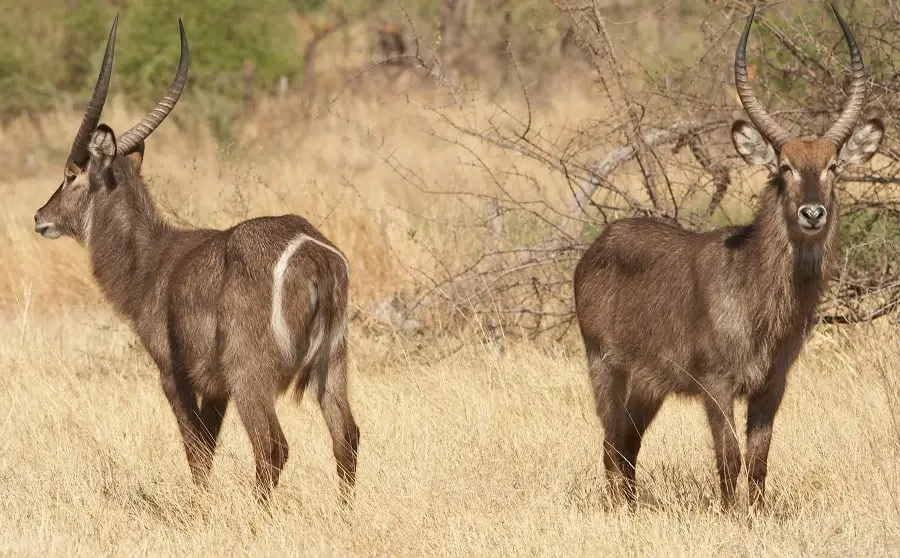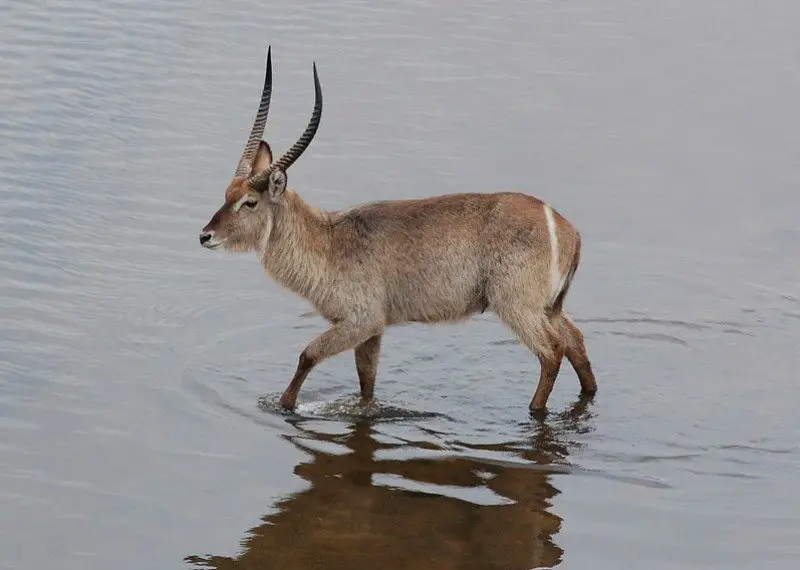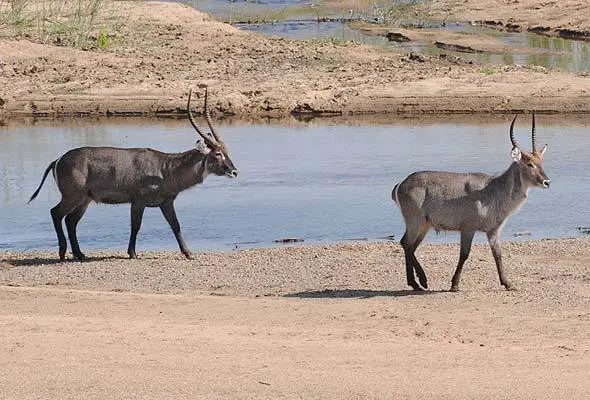Table of Contents
*This post may contain affiliate links. As an Amazon Associate we earn from qualifying purchases.
Africa has one of the most diverse wildlife ecosystems found in the world. While that’s fair to say of any independently established system found across any continent, there’s a certain charm that we’ve imprinted on the African wildlife. There’s a reason why circuses found such success in touring with a retinue full of these exotic animals, after all.
While it might not be among the most unique out of the African lineup, the waterbuck is no less an impressive form of life grown by Mother Earth. Graceful, elegant, and exclusive, they make for ideal fauna to be seen on safaris. In the words of Ernest Hemingway, there is “no more ruggedly handsome animal in all of Africa.”
There’s a certain appeal to the waterbuck sought after by many around the globe, whether it be in its form, how it behaves in its environment, or in the symbol of its being.
Where the Waterbuck Lives
The waterbuck is, despite the name, a land-dwelling antelope. Their name is derived from their particular dependence on bodies of water, used for a variety of survival needs and techniques. Due to their frequent sightings and attachment to water, they live in areas where that is readily available and plentiful. No oases necessary, the waterbuck isn’t found anywhere in or north of the Sahara, focused primarily in central to southern Africa.
They’re not as widespread as you might think either. The waterbuck is split between two groupings of the 13 subspecies: the Ellipsiprymnus waterbuck and the Defassa waterbuck. These two subspecies are found in two neighboring defined regions in Africa.
The Defassa waterbuck can be found in a strip from the Guinea coastline to about the middle of Zambia, Tanzania, and Kenya. From here the majority of the waterbuck population becomes dominated by the neighboring Ellipsiprymnus. The Ellipsiprymnus can then be found from this border to a large area of the coast stretching from Kenya into South Africa.
These regions are defined by their vast savannas, scrubs, and riverine woodlands, providing a natural preferred climate for the waterbuck. A waterbuck’s ideal environment is always going to be found by a nearby water source, such as a river or lake. These water sources provide a valuable, vital defensive and hydration-based requirement for their survival.
Waterbucks have been experiencing their habitats shrinking due to poaching and human expansion. While, yes, humans are responsible for this reduction, there is cause to say that waterbucks are susceptible to it due to their sedentary nature.
Waterbucks prefer, along with their water source, for there to be a wide, open field full of high grasses to provide sustenance for them and their young. Being antelopes, similar to many similar animals, they live in herds ranging between eight and thirty. How large the herds usually depends on what season it is. The colder months usually splinter herds into smaller groups due to food availability.

Waterbuck Behavior
Waterbucks, as their name insinuates, were named so because of their dependence on nearby permanent water sources. Primarily, waterbucks are unique in that they need to stay constantly hydrated, drinking from their chosen bodies of water on a daily, consistent basis. They dehydrate much more quickly than other antelopes.
However, due to their necessity for close proximity to a water source, waterbucks are able to use them as a defensive measure against predators. If being pursued, a waterbuck will run into deeper waters, even to the point where they swim to escape. Once this happens, the predators will lose interest and leave the waterbuck to their aquatic pursuits.
This systematic adaptation to using water as both a frequently used source and as a defensive measure has resulted in a few interesting evolutionary aspects they’ve gained. For one, waterbucks are excellent swimmers, which makes any bold predators’ pursuits into the water largely fruitless. Their prominent thick neck hair is hollow, which helps provide extra buoyancy once afloat.
In regards to defensive measures, male waterbucks are not too shy to take the fight to the predators themselves. Their horns aren’t just for show. They’re tough, sharp, and damaging when used in a fight.
The second evolutionary trait is a special excretion secreted through their skin. This oily substance provides waterproofing and insect-repelling benefits. The secretion has a notable reeking to it, which may help deter would-be predators from making them their next meal. Chances are this secretion is more beneficial when it comes to deterring predators like the crocodile, who are much more suited to aquatic hunting.
Waterbuck Territories
Waterbucks are not migratory creatures, mostly due to their dependence on permanent bodies on water to sustain themselves. Once they set up shop, they’re not likely to move very far from it. They will venture out around two to three kilometers from their stomping grounds, a fair distance to graze from. As sedentary creatures, the few pushes that will get them to change locations are nothing short of natural disasters, like monsoons.
Territories are generally established by a strong, dominant male waterbuck who congregates with all-male herds. Female waterbuck, along with their young, will end up wandering between territories, forming herds with other females, babies, or young males. Herds will end up being fairly diverse with the sex and age makeup of their populations.
Waterbucks are naturally very territorial, with territories only being controlled by males of the species. The territories themselves are generally small, around half a square mile or less, and during the time they control these areas they seldom pick up and move. There are a few circumstances in which a male waterbuck will change his territory.
- The male may decide to abandon his smaller territory and move up to a more spacious area.
- The male grows too old, around 10 years, and is replaced by a younger male. He then wanders off to a smaller, unprotected area of the wilderness.
- His territory is infringed upon by satellite males – dominant male waterbucks that have yet to claim territories of their own. They may allow these males in at first to help protect the area, but may eventually be usurped entirely.
- Natural disasters, of course.
Besides traditional droppings and urine, territory boundaries aren’t well defined. This isn’t much of a problem, since territories are generally small anyway, and may be beneficial for natural herd transfer and movement.

Food Sources
Like all antelope, waterbucks are herbivores, grazing on the surrounding tall grasses available in their area. Their sedentary lifestyle means they have a guaranteed food source year-round, and they aren’t immune to taking leftovers. They’ll frequently visit grassy areas that have already been fed on by other animals and go over the remains.
Waterbucks are not browsers, meaning they focus mainly on selections of wild grasses for their food source. They will, for a portion of their feeding times, browse leaves and berries of nearby trees and plants, but do so with significantly less spent effort doing so than other antelope species.
Reproduction and Aging
Once a female is impregnated during oestrus, it takes around eight months before her calf is born. During the early months of a calf’s life, they’re largely hidden by their mother from predators, secluded in thickets and other hiding spots. Unfortunately, as the mother often will leave them for periods of time, only coming back to feed them, calf mortality is high.
Males will reach full sexual maturity in six years, whereas females will reach the same level in less than half the time. Waterbucks are a bit slower when it comes to maturity in comparison to other antelope species. The male waterbuck will begin growing their horns between five and seven months after being born. Many are chased out of the herd at this time by older, mature males.
Waterbuck Summarization
Waterbucks are a handsome, surprisingly tough species of animal, despite being so keenly dependent on water sources. They live in grasslands, with up to 30 other friends, and enjoy a life that can reach up to 20 years.
Thankfully, these are animals presently not on any extinction list, or even coming close to reaching worrisome levels for the most part. The Ellipsiprymnus, or better known as the common waterbuck, is of the least concern on the IUCN list, and while the Defassa has reached Near Threatened level, it’s still doing fairly well despite man-made threats.

